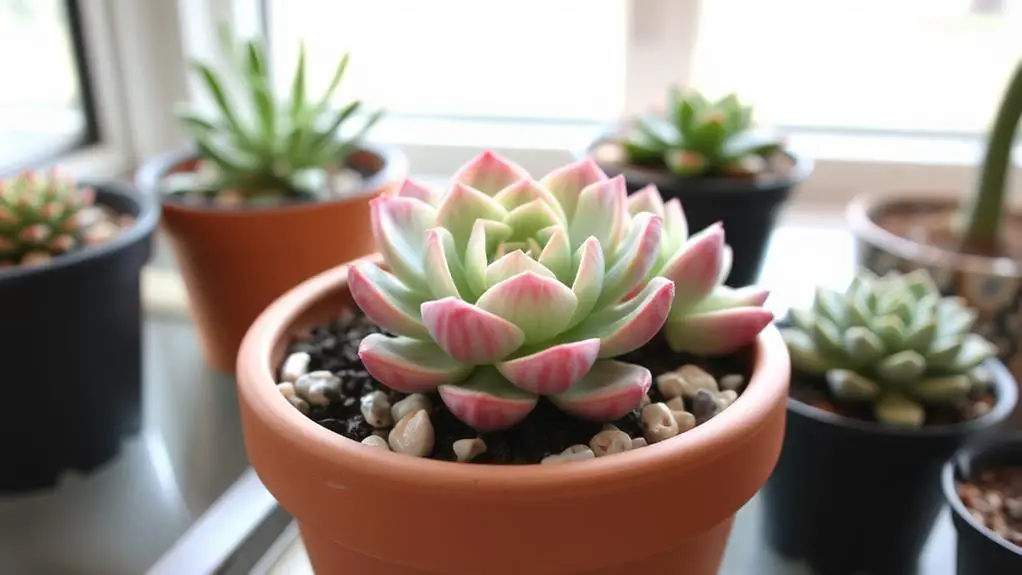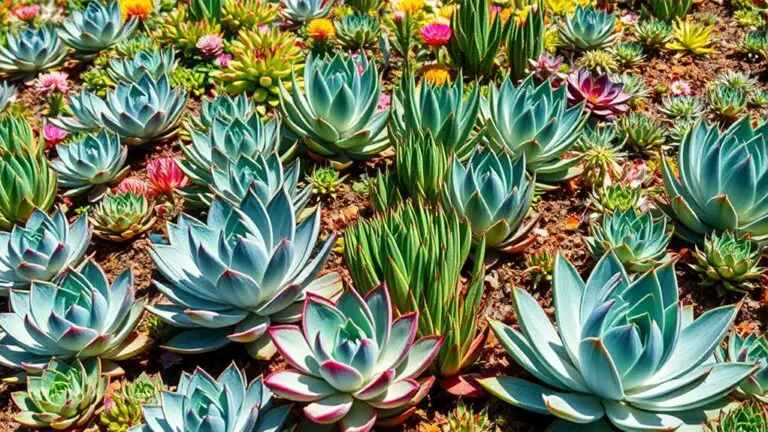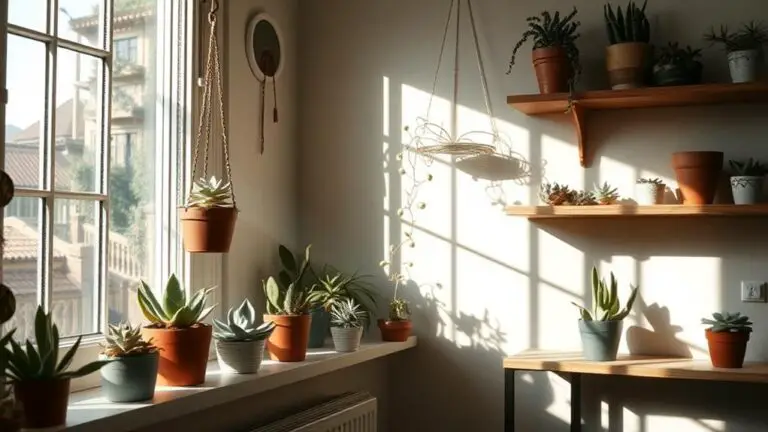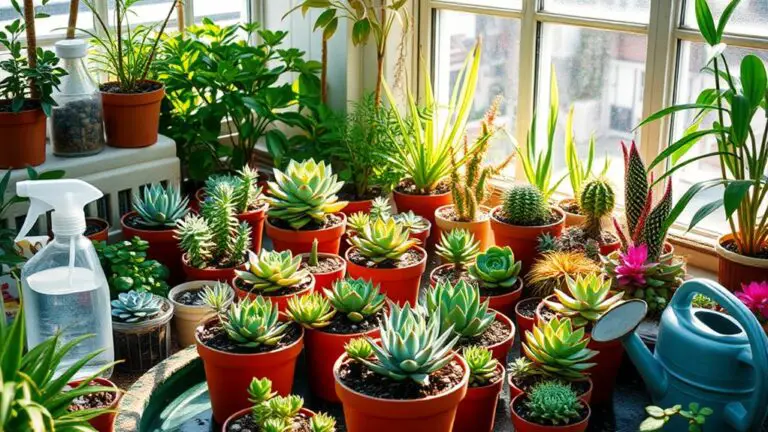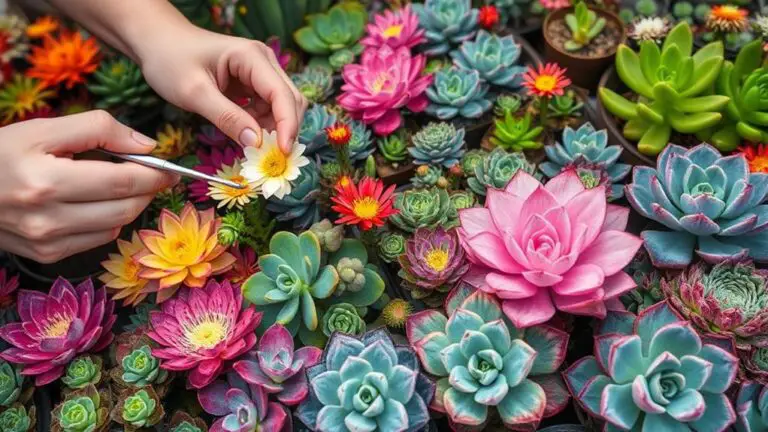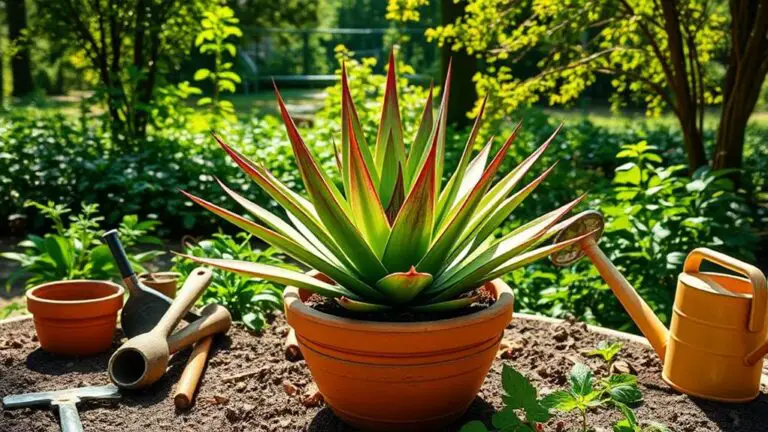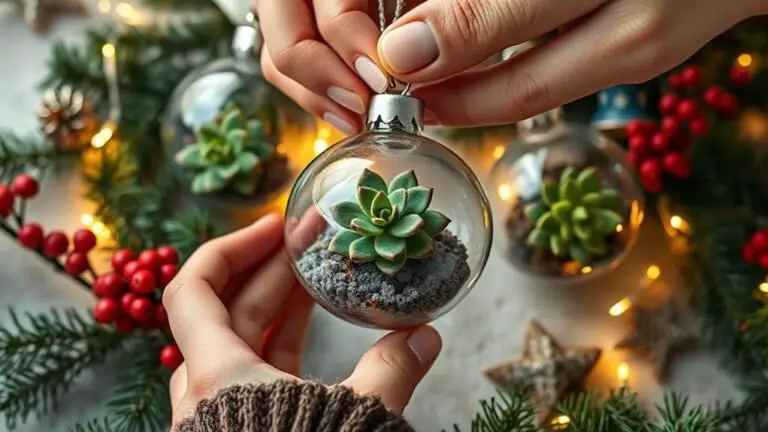Echeveria ‘Cubic Frost’ Care Tips for Success
Caring for an Echeveria 'Cubic Frost' can be rewarding if you get the basics right. You need to provide bright, indirect sunlight and be cautious with watering—only every 2-3 weeks during its growing season. It thrives in temperatures between 60-75°F and must be shielded from extreme cold. The key is well-draining soil with 50-70% mineral grit. Monthly fertilization in spring and summer boosts its growth, but don't forget to regularly inspect for pests like mealybugs. Wondering how to prevent root rot or the best potting practices? Let's explore further.
Overview and General Care
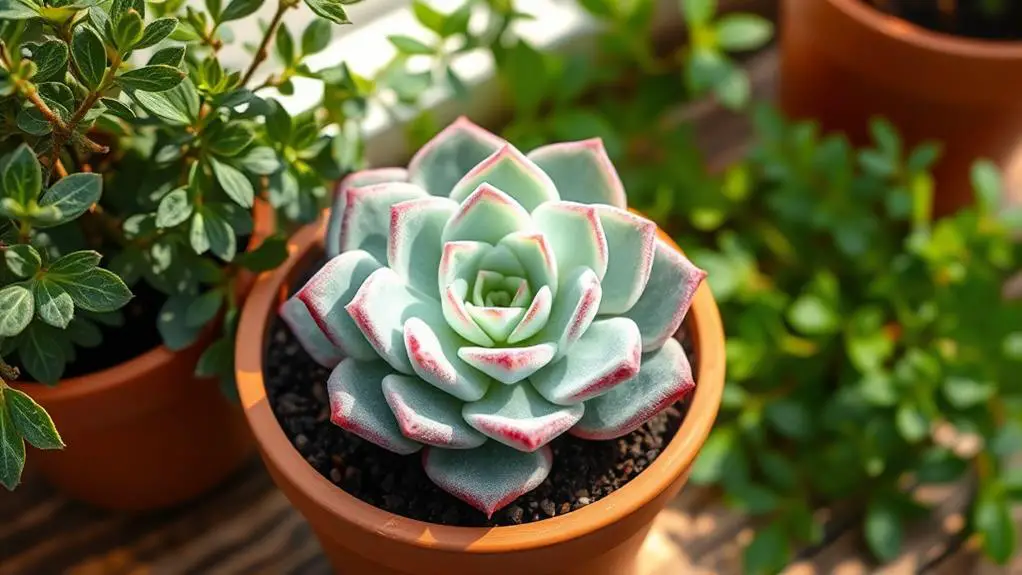
Echeveria 'Cubic Frost' is a stunning hybrid succulent known for its compact rosettes with pointy, fleshy leaves that display a mix of blue, silver, and lilac hues, reaching up to 10 inches in diameter.
To guarantee your Echeveria thrives, understanding its basic care needs is vital.
This succulent loves bright, indirect sunlight. It's best to avoid direct afternoon sun during the summer to prevent sunburn. Morning sunlight or a spot with filtered light works well.
If you notice the leaves losing their vibrant color or stretching out, your Echeveria might need more sunlight.
Watering is another key aspect. Unlike most houseplants, Echeveria prefers to be watered infrequently. Typically, every 2-3 weeks is enough during the growing season.
Make sure the soil is completely dry before watering again. Overwatering can lead to root rot, which is a common issue with succulents.
Ideal Growing Conditions
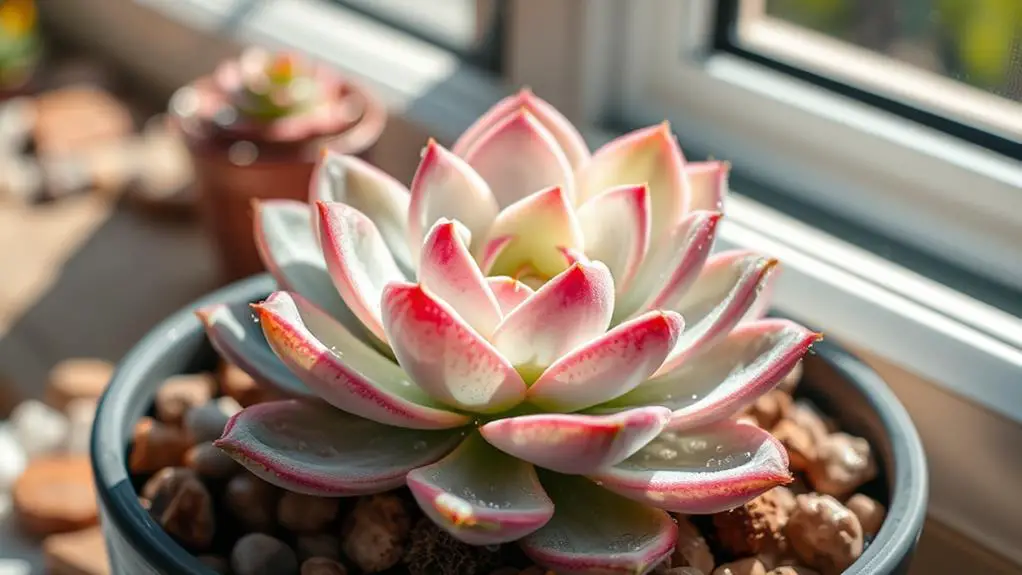
When it comes to creating the ideal growing conditions for your Echeveria 'Cubic Frost,' bright, indirect sunlight is key. Place it within 3 feet of a south-facing window for the best growth. While this succulent can handle full sun, especially in cooler temperatures, it's wise to offer some afternoon shade during the summer to prevent sunburn.
To guarantee your plant thrives, consider the following conditions:
- Temperature: Aim to keep the temperature between 60-75°F. Echeveria Cubic Frost can tolerate highs up to 90°F and lows down to 15-30°F for short periods, but protect it from prolonged freezing.
- Humidity: Low to medium humidity levels (30-40%) are ideal for this succulent. Keeping an eye on humidity is essential to avoid any issues.
- Sunlight: Bright, indirect light is preferred, but it can tolerate full sun with some protection during hotter periods. Afternoon shade in summer months will help avoid sunburn.
Watering Guidelines
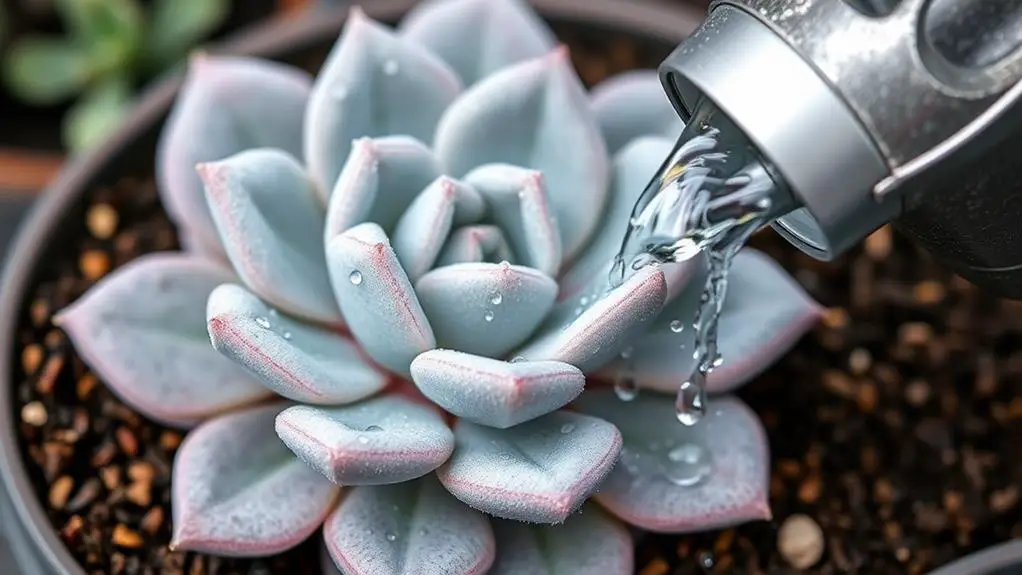
With the ideal growing conditions established, let's focus on the watering guidelines for your Echeveria 'Cubic Frost.' Maintaining proper watering habits is crucial to the health of your succulent.
You'll want to water your Echeveria 'Cubic Frost' about 0.5 cups every 12 days, but this can change depending on sunlight and environment. Always check the soil moisture first. Only water the plant when the soil is completely dry. This helps prevent overwatering, which can lead to root rot.
When you water, do it thoroughly. Make sure the excess water drains out. This guarantees the roots don't sit in water, which succulents like Echeveria 'Cubic Frost' don't tolerate well.
During spring and summer, cut back on watering to every 2-3 weeks. Your plant will need less water in these growing seasons. In winter, the plant requires even less frequent watering.
To make it easier, consider using a water calculator. This tool can help you adjust the watering schedule based on your specific conditions, guaranteeing your Echeveria 'Cubic Frost' gets just what it needs.
Keep an eye on the soil moisture and adjust your routine as needed. You'll have a happy, healthy succulent in no time!
Soil and Fertilization
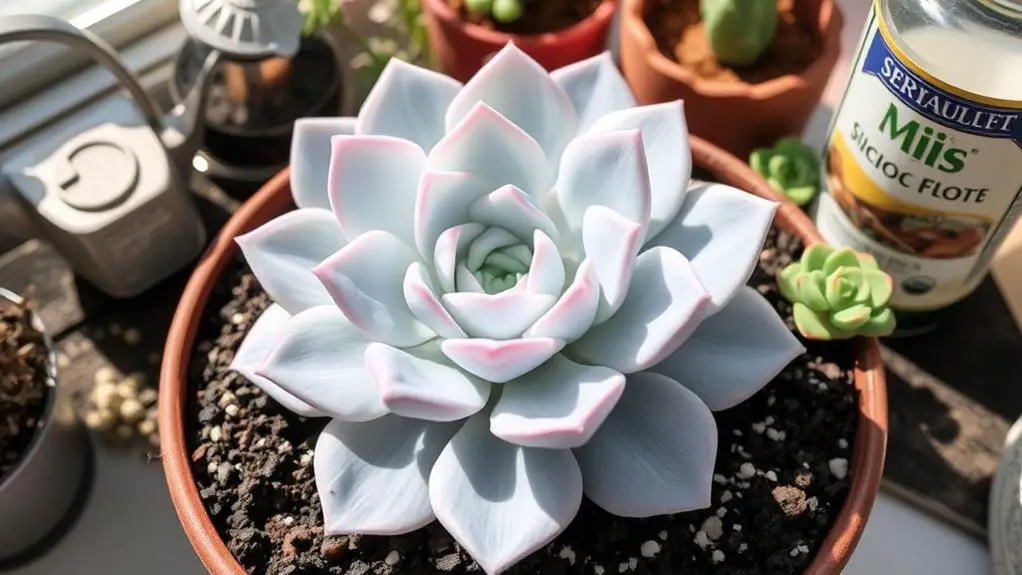
For your Echeveria 'Cubic Frost', choosing the right soil is essential.
Use a well-draining, porous mix with 50% to 70% mineral grit to keep roots healthy and avoid rot.
Fertilize once a month during spring and summer with a diluted balanced fertilizer, but remember that high-quality potting soil often provides enough nutrients initially.
Well-Draining Soil Importance
Guaranteeing your Echeveria 'Cubic Frost' is planted in well-draining soil is vital for its health and longevity. This succulent thrives when moisture doesn't linger around its roots, as it helps to prevent root rot and other common issues.
Here are some tips to guarantee your plant gets the best soil conditions:
- Choose the Right Soil Mix: A mix containing 50% to 70% mineral grit like perlite or vermiculite will enhance drainage. This type of soil doesn't hold onto water, which is perfect for your Echeveria.
- Avoid Heavy Soils: Steer clear of heavy, moisture-retentive soils. These can cause fungal infections and yellowing leaves, which are signs your plant is struggling.
- Annual Repotting: Repotting your Echeveria 'Cubic Frost' annually with fresh succulent potting mix helps replenish nutrients and maintain good soil conditions. This keeps your plant healthy and thriving.
Proper soil management is essential. Well-draining soil allows your Echeveria to absorb necessary nutrients without becoming over-saturated, which helps it grow strong and beautiful.
Fertilizing Frequency Guidelines
When it comes to fertilizing your Echeveria 'Cubic Frost', understanding the right frequency can make a significant difference in its health and growth. While fertilization is optional, it can be beneficial during the growing season, which spans spring and summer. Aim to use a diluted, balanced fertilizer once a month during these active growing periods. This helps provide essential nutrients that support robust growth.
It's important to note that most potting soils come with enough initial nutrients. You don't need to worry about fertilizing until you notice signs of nutrient depletion, like slower growth or pale leaves.
Remember, your Echeveria 'Cubic Frost' will enter a dormant phase during the winter months. Avoid fertilizing during this time, as the plant isn't actively growing and could be harmed by unnecessary nutrients.
Annual repotting is another key aspect of maintaining plant health. When your Echeveria has doubled in size, it's a good sign that it might be time to repot.
Repotting helps refresh the soil and replenish nutrients, ensuring your plant continues to thrive. By monitoring your plant's growth and health, you can determine when repotting or additional fertilizing is needed, setting you up for gardening success.
Nutrient-Rich Soil Choices
After understanding the fertilizing needs of your Echeveria 'Cubic Frost', it's equally important to focus on the soil it grows in. For your plant to thrive, you need to select nutrient-rich soil choices that support its health. The key is choosing well-draining soil to prevent root rot and other issues.
First, consider a cactus and succulent soil mix. These mixes usually contain the right balance of nutrients and texture to keep your Echeveria happy. Ideally, the mix should include 50% to 70% mineral grit like perlite or pumice to enhance drainage.
Second, steer clear of heavy soils that retain moisture. These can cause root issues and fungal infections, which can be detrimental to your plant's health.
Third, repot your Echeveria annually, especially if it doubles in size or the potting soil has degraded. This helps replenish nutrients and guarantees the soil remains well-draining.
Here's a quick summary:
- Use cactus and succulent soil mix with 50% to 70% mineral grit.
- Avoid heavy, moisture-retaining soils to prevent root issues.
- Repot annually to keep the soil nutrient-rich and well-draining.
Common Pests and Problems

Echeveria 'Cubic Frost' can run into several common pests and problems that require vigilant care. Keep an eye out for pests like mealybugs and aphids. These tiny intruders can harm your plant, but regular inspections and prompt treatment can keep them at bay.
Overwatering is another common issue. Too much water can lead to fungal infections and root rot. Make certain your pot has proper drainage and avoid soaking the soil. Yellowing leaves often mean you're overwatering, so cut back if you notice this.
Proper light exposure is essential for Echeveria 'Cubic Frost'. If you see red stress coloring on the leaves, it might mean your plant isn't getting enough sunlight. Move it to a brighter spot, but avoid direct, harsh sunlight.
Environmental stress can also cause leaf drop. Regularly monitor humidity and temperature to keep them stable, as fluctuations can stress out your plant.
In short, keep an eye on pests, avoid overwatering, and guarantee proper light exposure. By paying attention to these details, you'll help your Echeveria 'Cubic Frost' thrive and stay healthy.
Don't worry, with a little care, your plant will reward you with its unique beauty.
Potting and Repotting
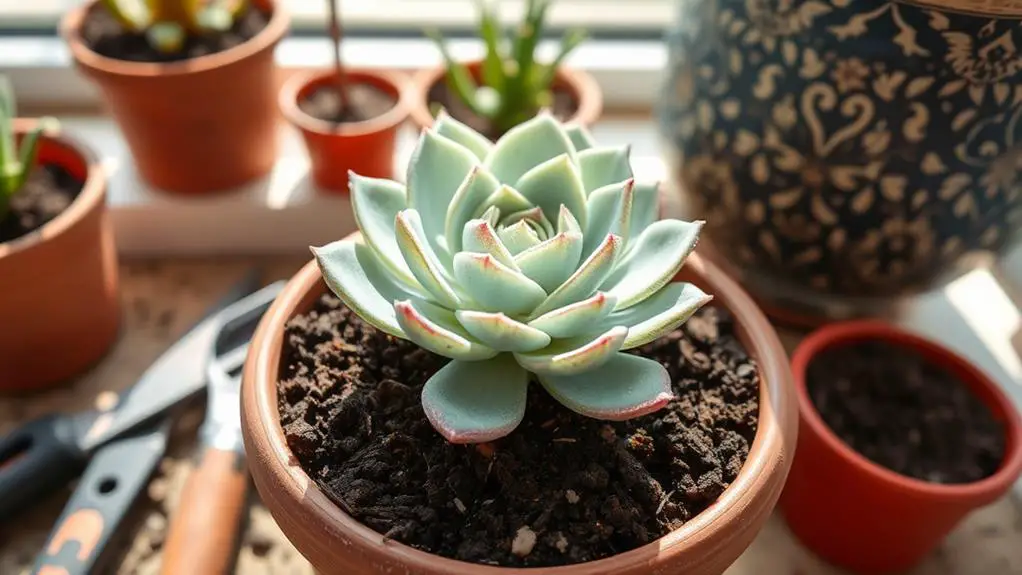
When potting your Echeveria 'Cubic Frost,' choose a 5-inch pot with drainage holes to prevent water buildup and root rot.
Repot your plant annually or when it doubles in size, using fresh succulent mix to keep it nourished.
Remember to use well-draining soil with plenty of mineral grit like perlite or vermiculite to help the roots stay healthy.
Choosing the Right Pot
Choosing the right pot is vital for the health and growth of your Echeveria 'Cubic Frost'. Start by selecting a pot that's at least 5 inches in diameter and equipped with drainage holes. These holes are essential to prevent waterlogging and support your plant's need for well-draining soil.
When potting soils come into play, always go for a high-quality succulent or cactus mix. Ideally, this mix should contain 50% to 70% mineral grit to guarantee optimal drainage.
Choosing the right material for your pot is also important. Terracotta and ceramic pots are great options because they allow for better air circulation and help regulate moisture levels. However, avoid black pots in hot climates as they can retain too much heat, which can harm the plant's roots.
Here's a quick checklist to help you choose the right pot:
- Size and Drainage: Verify the pot is at least 5 inches in diameter and has drainage holes.
- Material: Opt for terracotta or ceramic to promote air circulation and moisture regulation.
- Soil Mix: Use a high-quality succulent or cactus potting mix with 50% to 70% mineral grit.
Annual Repotting Guidelines
After selecting the perfect pot, it's important to take into account the annual repotting of your Echeveria 'Cubic Frost'. Annual repotting helps replenish soil nutrients and gives your plant more space to grow, as it can double in size over time. Choose a well-draining succulent potting mix with 50% to 70% mineral grit; this prevents root rot and keeps your plant healthy.
When repotting, go for a pot that's one size larger than the current one, ideally a 5-inch pot. Repotting during the spring or summer, when your Echeveria is actively growing, allows it to recover quickly and establish itself in the new soil.
| Step | Action | Why It's Important |
|---|---|---|
| Choose Pot | Select a pot one size larger (5-inch) | Provides space for growth |
| Soil Mix | Use well-draining mix with mineral grit | Prevents root rot |
| Inspect Roots | Check for rot or damage, trim if necessary | Guarantees only healthy roots remain |
Always inspect the roots for any signs of rot or damage. Trim away unhealthy sections before placing your plant in fresh, well-draining soil. This guarantees your Echeveria 'Cubic Frost' stays healthy and vibrant. By following these steps, you'll create an ideal environment for your plant to thrive.
Frequently Asked Questions
How to Care for Echeveria Frosty?
Water your echeveria frosty sparingly, about 0.5 cups every 12 days. Make certain it gets bright, direct sunlight and use well-draining soil. Keep humidity at 30-40%, maintain temperatures between 60-75°F, and check for pests regularly.
How Do You Care for Cubic Frost Succulents?
Place your Cubic Frost in bright, indirect sunlight, water it with 0.5 cups every 12 days during the growing season, and let the soil dry out. Use well-draining soil, monitor for pests, and reduce watering in winter.
Can Echeveria Survive Frost?
Echeveria can't survive prolonged frost. It tolerates temperatures down to 15-30°F but needs protection below 32°F. Bring it indoors during deep freezes to prevent leaf damage, discoloration, and potential plant death.
Is Echeveria Elegans Frost Hardy?
Echeveria elegans isn't frost hardy. You should protect it from freezing temperatures. If it's exposed to frost, move it indoors. Watch for signs of damage like leaf discoloration or mushiness, and act quickly to save it.
Conclusion
Taking care of your Echeveria 'Cubic Frost' might seem tricky at first, but with these tips, you'll do great! Remember to give it bright, indirect light and water sparingly. Keep it in well-draining soil and protect it from extreme temperatures. Don't forget to check for pests and repot annually. With a little attention and care, your plant will thrive. You've got this, and your Echeveria 'Cubic Frost' will thank you!

